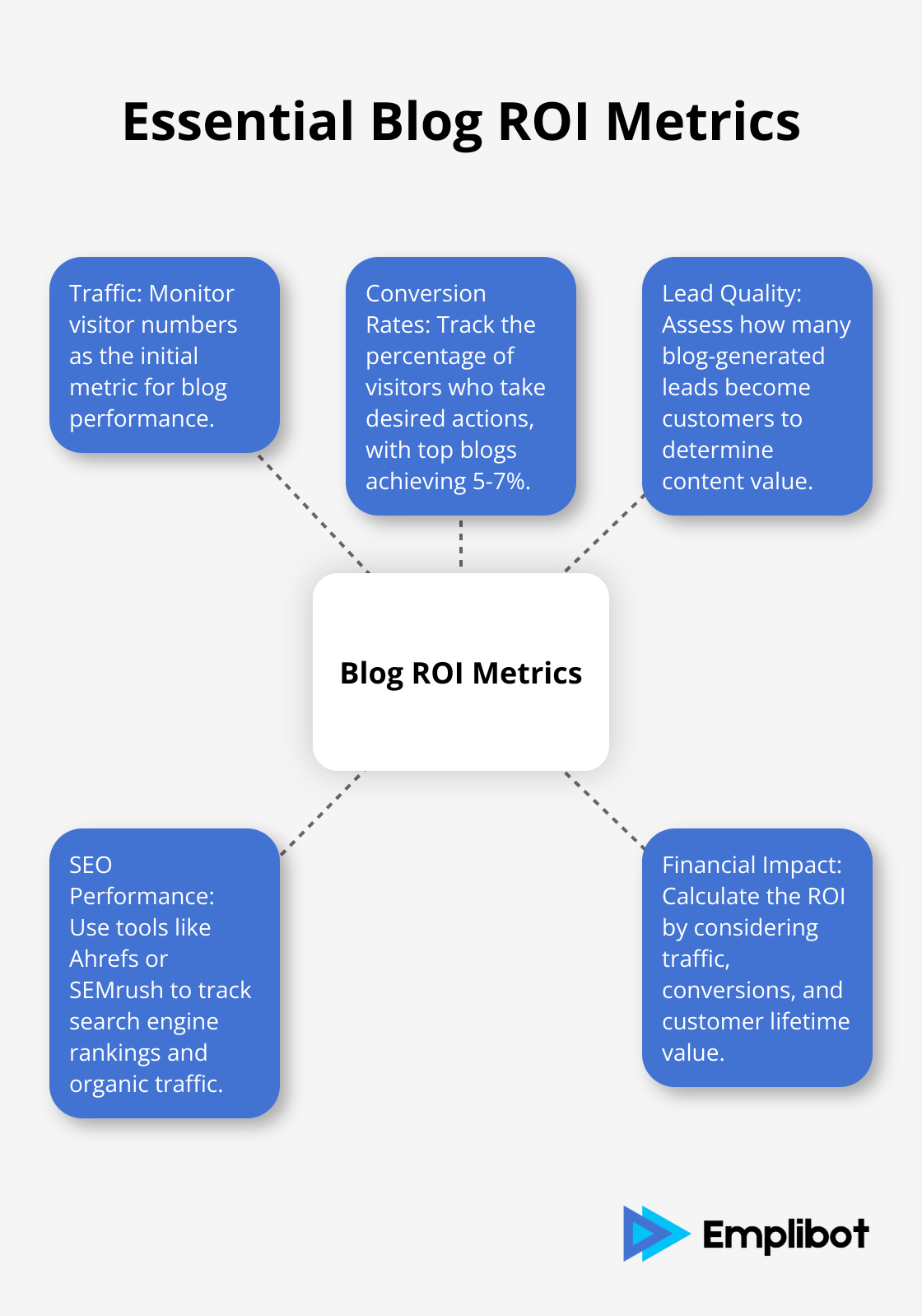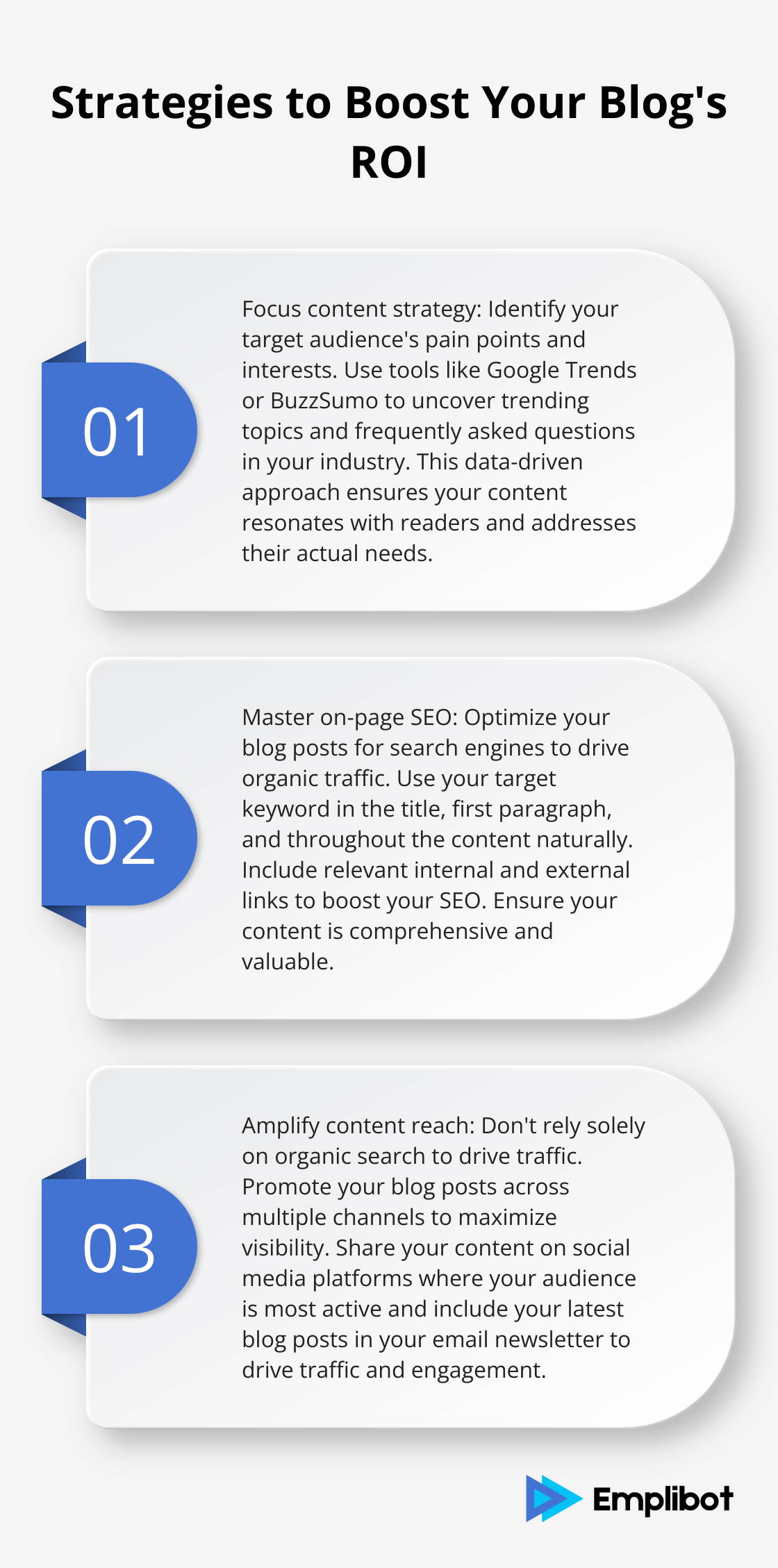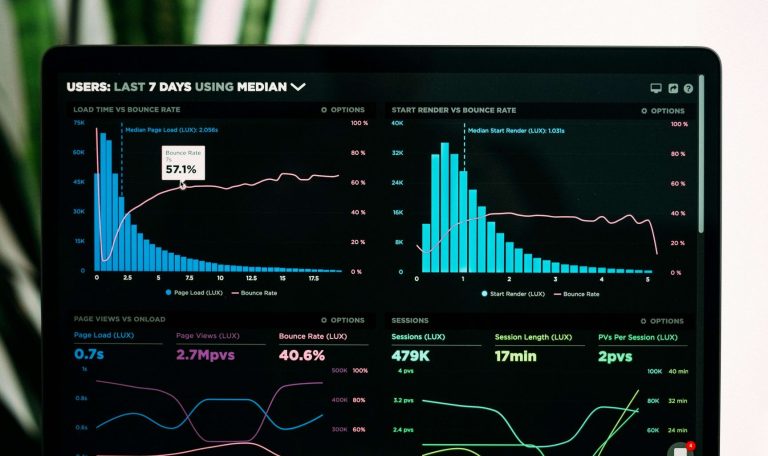At Emplibot, we often get asked: “What’s the ROI of blogging?” It’s a crucial question for businesses considering investing in content marketing.
In this post, we’ll explore why every serious company needs a blog and how to calculate its return on investment. We’ll also share strategies to maximize your blog’s ROI and provide you with practical tools to measure your success.
Contents
ToggleWhy Every Serious Company Needs a Blog
The SEO Powerhouse
A blog transforms your website into an SEO powerhouse. HubSpot reports that companies with blogs receive 55% more website visitors than those without. This increased visibility directly translates to more potential customers discovering your business.

Blogs allow you to target long-tail keywords, which often have higher conversion rates. They also provide search engines with more content to index, increasing your chances of ranking for a variety of relevant searches.
Building Trust and Authority
Blogging establishes your company as a thought leader in your industry. A study by Viral Solutions found that 68.5% of consumers believe blogs add credibility to a website. Sharing valuable insights and expertise doesn’t just attract visitors-it earns their trust.
This trust pays off. According to Content Marketing Institute, 71% of B2B buyers engage with blog content during their buyer’s journey. Educating potential customers positions your company as the go-to source for solutions in your field.
The Long-Term Investment
Unlike paid ads (which stop delivering results the moment you stop paying), blogs are a long-term asset. Each post you publish continues to attract traffic and generate leads for years to come. It’s like planting a tree-it takes time to grow, but once it does, it bears fruit season after season.
This compounding effect is powerful. HubSpot reports that companies publishing 16+ blog posts per month get almost 3.5 times more traffic than those publishing 0-4 monthly posts. Over time, this consistent effort creates a formidable content library that works for you 24/7.
Cost-Effective Marketing
While paid ads have their place in a marketing strategy, they can’t match the sustainability and cost-effectiveness of blogging. With the average cost-per-click rising across many industries, a well-executed blogging strategy offers a more budget-friendly approach to attracting and converting leads.
In the digital age, content is currency. Investing in a blog doesn’t just mean publishing posts-it means building a valuable asset that will continue to pay dividends for years to come. If you haven’t started blogging yet, now is the perfect time. If you have, it’s time to double down on your efforts. Your future customers are out there, searching for the solutions you offer. A strong blog ensures they find you.
Now that we understand why blogging is essential for every serious company, let’s explore how to calculate its return on investment.
How to Measure Blogging ROI
Essential Metrics for Blog Performance
Traffic serves as the initial metric businesses track, but it represents only the beginning. While visitor numbers matter, conversion rates tell a more compelling story. A study by Databox reveals that the average conversion rate for blog traffic ranges from 1-3%. Top-performing blogs, however, can achieve rates as high as 5-7%.
Lead quality stands out as another critical metric. Inbound leads cost 62% less than outbound leads, according to HubSpot. Track how many of your blog-generated leads transform into customers to assess the true value of your content.

Tools for Accurate ROI Tracking
Google Analytics remains the gold standard for tracking blog performance. It offers detailed insights into traffic sources, user behavior, and conversion paths. For a more comprehensive view, integrate Google Analytics with your CRM system to track leads from first touch to final sale.
SEO tools like Ahrefs or SEMrush prove invaluable for monitoring your blog’s search engine performance. These tools help you identify which posts drive the most organic traffic and backlinks, allowing you to replicate successful content strategies.
Real-World Success Stories
Let’s examine some concrete examples of blogging ROI. Buffer (a social media management platform) attributes a significant portion of their signups to their blog content. They’ve consistently invested in high-quality, data-driven posts that resonate with their target audience.
Another success story comes from Groove (a customer service software company). By focusing on transparent, value-packed content, they grew their blog to 250,000 monthly readers and $5 million in annual recurring revenue.
These case studies underscore an important point: blogging success doesn’t happen overnight. It requires consistent effort and a data-driven approach to content creation and optimization.
Calculating Your Blog’s ROI
To help you start calculating your own blogging ROI, try using a free blogging ROI calculator (such as the one offered by Emplibot). This type of tool takes into account various metrics like traffic, conversion rates, and customer lifetime value to give you a clear picture of your blog’s financial impact.
ROI isn’t just about immediate financial returns. The long-term benefits of increased brand awareness, improved customer trust, and enhanced search engine rankings all contribute to your blog’s overall value.
Now that we’ve covered how to measure your blog’s ROI, let’s explore strategies to maximize these returns and turn your blog into a powerful engine for business growth.
How to Boost Your Blog’s ROI
Maximizing your blog’s return on investment requires a strategic approach that goes beyond simply publishing content. Here’s how you can supercharge your blog’s ROI:

Focus Your Content Strategy
Identify your target audience’s pain points and interests. Use tools like Google Trends, AnswerThePublic, or BuzzSumo to uncover trending topics and frequently asked questions in your industry. This data-driven approach ensures your content resonates with readers and addresses their actual needs.
For keyword research, tools like Ahrefs or SEMrush can help you find high-volume, low-competition keywords. Focus on long-tail keywords, which often have higher conversion rates. A study by Backlinko found that long-tail keywords have a 3-5% higher click-through rate compared to generic searches.
Master On-Page SEO
Optimize your blog posts for search engines to drive organic traffic. According to a study by Ahrefs, the average top-ranking page on Google is 1,447 words long. However, don’t just focus on length; ensure your content is comprehensive and valuable.
Use your target keyword in the title, first paragraph, and throughout the content naturally. Include relevant internal and external links to boost your SEO. A study by Moz found that pages with internal links rank higher in Google search results.
Amplify Your Content’s Reach
Don’t rely solely on organic search to drive traffic. Promote your blog posts across multiple channels to maximize visibility. Share your content on social media platforms where your audience is most active. According to Hootsuite, 52% of online brand discovery happens on social media.
Email marketing remains a powerful tool for content promotion. Campaign Monitor reports that email marketing drives an ROI of $44 for every $1 spent. Include your latest blog posts in your newsletter to drive traffic and engagement.
Repurpose for Maximum Impact
Boost reach, save time, and increase ROI with content repurposing. Learn proven strategies to scale your content marketing efforts across platforms.
Transform your blog posts into video content for platforms like YouTube or TikTok. Cisco predicts that by 2025, 82% of all internet traffic will be video. This strategy allows you to tap into new audiences and reinforce your message across multiple channels.
Analyze and Adjust
Regularly analyze your performance metrics and adjust your strategy accordingly. Try to identify which types of content perform best (in terms of traffic, engagement, and conversions) and create more of it. Use tools like Google Analytics to track your progress and make data-driven decisions about your content strategy.
Final Thoughts
Blogging offers substantial returns on investment for businesses. Companies with blogs generate more leads, attract more website visitors, and build stronger relationships with their audience. The ROI of blogging stems from consistent, high-quality content creation that focuses on valuable, targeted information optimized for search engines. We encourage you to use our free blogging ROI calculator to visualize the potential returns from your blogging investment.
Emplibot provides a comprehensive solution to streamline content marketing efforts. It automates WordPress blogs and social media, handling everything from keyword research to content creation and SEO optimization. With Emplibot, you can increase your traffic, leads, and sales while saving valuable time and resources.
The future of your company’s online presence starts with the content you create today. Embrace the power of blogging and watch your business grow. The potential for growth is immense, and the cost-effectiveness of blogging makes it an attractive option for businesses of all sizes.


![Google Business Profile Optimization [Local SEO]](https://wp.emplibot.com/wp-content/uploads/emplibot/google-business-profile-optimization-hero-1756624038-768x456.jpeg)



![SEO Content Creation [Tips and Techniques]](https://wp.emplibot.com/wp-content/uploads/emplibot/seo-content-creation-hero-1756278494-768x456.jpeg)



